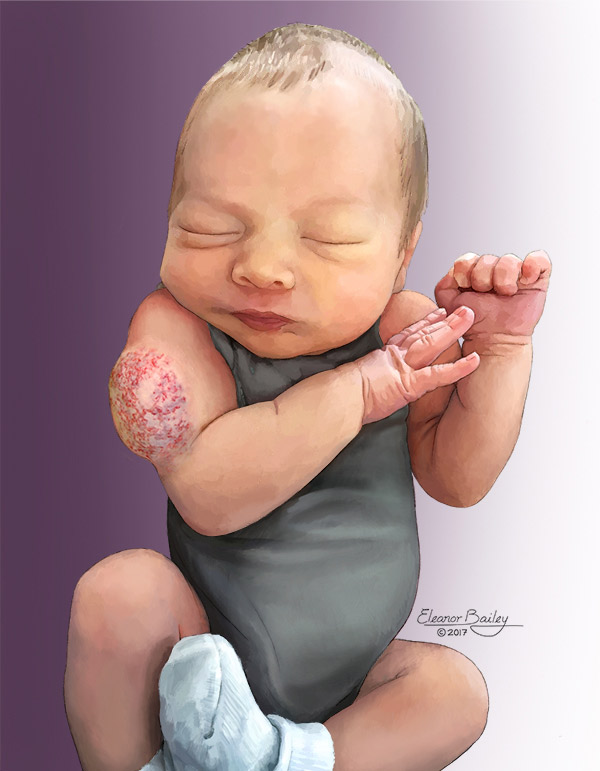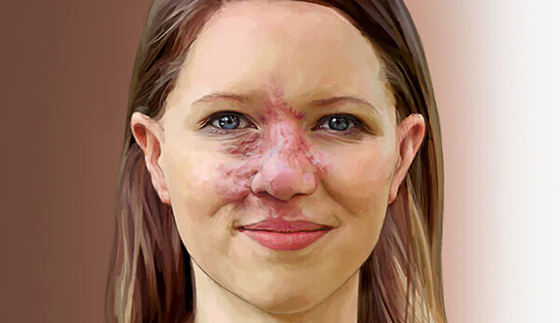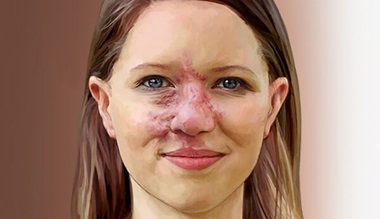Congenital Hemangioma
Congenital hemangiomas are vascular lesions that are fully formed at birth and occur when blood vessels form abnormally. The cells that form blood vessels are called endothelial cells. In a congenital hemangioma, these cells multiply more than they should. The extra tissue forms a benign tumor attached to normal blood vessels. The cause is unknown.
Congenital hemangiomas can sometimes be seen on prenatal ultrasound during pregnancy. Congenital hemangiomas are usually round or oval in shape, raised and warm to the touch. They are dark pink to blue or purple in color, with lots of tiny red veins visible on the skin (telangiectasias) and light or pale-colored skin (pallor) around the edges.
Congenital hemangiomas are usually divided into two groups: rapidly involuting congenital hemangioma (RICH) and non-involuting congenital hemangioma (NICH).
Congenital hemangiomas are fully grown when the baby is born, but they do not grow after birth. A RICH will start to shrink right after the baby is born. By 1 to 1 1/2 years of age, the RICH may be almost completely gone. Sometimes loose scar tissue is left behind. A NICH does not get smaller after the baby is born. Both may need treatment.
Congenital hemangiomas will sometimes shrink but will not fully go away. These are sometimes called partially involuting congenital hemangiomas (PICH).
Ultrasound shows that the blood vessels that make up a congenital hemangioma have thin walls and blood flows through them quickly. They are most common on the skin, arms, legs, head or neck, and they are occasionally found in the liver.
Congenital hemangiomas are equally common in boys and girls, though much less common than infantile hemangiomas.

Illustration of an infant with a congenital hemangioma on their upper arm.
© Eleanor Bailey
How are congenital hemangiomas diagnosed?
Doctors can diagnose most congenital hemangiomas by doing an exam and asking about the pregnancy and the baby’s health. Most hemangiomas do not need any special tests. If a doctor thinks your child has a congenital hemangioma, he or she may use ultrasound to see more details inside the hemangioma to confirm the diagnosis.
It can be difficult right after birth to tell the difference between a RICH and a NICH. If the hemangioma becomes smaller after birth, it is a RICH. If its size doesn’t change, it is a NICH.
Our Approach to Treating Vascular Anomalies
Johns Hopkins Medicine has developed a multidisciplinary Vascular Anomalies Center in order to offer patients individualized treatment. As a leader in diagnosing, researching and treating vascular anomalies and vascular tumors, our team of specialists provide comprehensive treatment and care.
How are congenital hemangiomas treated?
Your child’s pediatrician, a dermatologist and sometimes a hematologist (a doctor who specializes in disorders of the blood), plastic surgeon or other surgeon will care for your child’s congenital hemangioma.
Infants with large congenital hemangiomas should be seen by a doctor who specializes in abnormalities of the vascular system. They can decide with you if treatment is needed.
During the first year of life, doctors will want to check the hemangioma often. Checkups will depend on the size of the hemangioma, where it is located on the body and whether it is causing any problems. If the hemangioma starts causing problems, treatment will be recommended.
Any hemangioma with an ulcer that bleeds or one that affects feeding, seeing or breathing needs treatment. Rarely, large congenital hemangioma can cause heart problems because of the amount of blood flowing into them.
There are no medicines proven to treat congenital hemangioma.
If surgery is needed, it is usually done between the ages of 2 and 5. Some parents choose to wait until the child is old enough to decide whether to have surgery.
Laser treatments are sometimes used in addition to or instead of surgery.
Rapidly Involuting Congenital Hemangioma (RICH)
A RICH is less likely to need treatment. It will get smaller on its own as the baby grows. It usually doesn’t cause any problems during infancy. If it does, your doctor will recommend treatment.
Watchful waiting is often the best treatment. If scar tissue is left behind after shrinking, laser treatment or surgery may be needed.
Non-Involuting Congenital Hemangioma (NICH)
A NICH will not shrink without treatment. If a NICH causes problems or is very large, your doctor will let you know if your child needs to see a surgeon or another specialist. For very large NICH, an interventional radiologist may need to embolize (block) bigger blood vessels in the lesion before surgery. This will help reduce the risk of bleeding during surgery.





